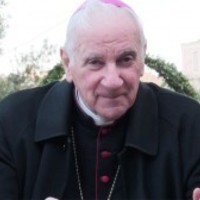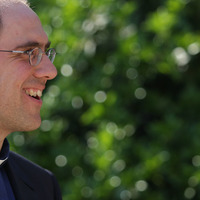
Alessio Persic
I am Friulian of Slovenian descent, son of the Patriarchate of Aquileia
less
Related Authors
Henryk Pietras
Pontificia Università Gregoriana
Vito Sibilio
Università degli Studi di Bari
Daniele Gianotti
Facoltà Teologica dell'Emilia-Romagna
Francesco Verde
Sapienza University of Roma
Sabrina Antonella Robbe
Università degli Studi "G. d'Annunzio" Chieti Pescara
Maurizio Girolami
Facoltà Teologica del Triveneto
InterestsView All (13)










Uploads
Papers by Alessio Persic
La traduzione della disputa fra il laico filoniceno Eracliano e il vescovo della illirica Sirmium, Germinio, divulga un pittoresco documento di cronaca ecclesiale – ma anche di esegesi biblica e teologia trinitaria militanti – dal quale si può ricavare la sostanza paradigmatica di episodi analoghi durante la controversia ariana specialmente in area illirica, come per esempio le contestazioni fatte da Martino da Sabaria, dove questi laici, in forza della loro “semplicità” – ovvero “rusticità” – dottrinale e di indole, si rendevano carismaticamente trasparenti di una spiritualità cristiana incompatibile con dottrine diverse dalla nicena, difesa in Aquileia – con Atanasio – dal vescovo Fortunaziano.
Renewed ritual of the blessing of water and salt practiced in Friuli on the eve of the Epiphany according to the Aquileian patriarchal liturgical tradition (with a short historical introduction).
In the recent forty years many advances in knowledge of theology, liturgy and spirituality of Christian Aquileia are due to the discovery of new literary sources and to the consequent identification of specific influences from Asia Minor, Syria and Egypt up from the second century: their persistence is clearly recognizable until after the fourth century, when the cultural exchange with the Near East is briskly nourished by the presence there of innovative and internationally influential Aquileian personalities, as well as by the relations entertained by the bishops of Aquileia with the centers and the most outstanding exponents of the complex reality of the Churches of Greek language.
The evidence of an independent Illyrian tradition about Martin leads us to point out that the homeland (patria) recognized by Martin himself as his own was in fact the Illyrian-Pannonian region, exposed to the evangelizing action of Aquileia and affected – at least since the mid-third century – by the widespread phenomenon of hermitical secessions from urban civilization, with the purpose of a preparation for martyrdom. St. Martin felt drawn to them already as a young boy during his stay in Sabaria, while adhering to Christianity preached according to the tradition of Aquileia, as it is revealed by some characteristic features of his spirituality; so when, returning from his patria, he undertook outside the walls of Milan the anachoresis that finally he propagated in Gaul, his monastic style, however, perpetuated the archaic model of these pre-Constantinian monasteria / tabernacula he had admired in his own region of birth, not far from Aquileia.
Hotbeds of ‘heresy’ in Aquileia in the mid-fifth century. The Aquileian Libellus fidei of 418. Rufinus ‘Pelagian’ ante litteram? Elements of plausibility of the accusation of Hieronymus in the mental context of his anti-Origenism. Free will and baptism in Rufinus’ 'Recognitiones'. An Aquileian network of ‘Propelagian’ indulgences… The ‘merciful’ spirituality of Martin of Sabaria, monk and bishop of Tours. From Irenaeus to Chromatius: the anthropological and soteriological paradigm of Adam, who from a subject of guilt becomes an object of mercy. Chromatius: the spiritual trait of ‘condescension’. From Chromatius to Pelagius…
By what right can an ancient Latin Christian author be defined as ‘Aquileian’? Beyond extrinsic data, such as birth or activity within the geographical area of the jurisdiction or of the even broader economic and cultural influence of Aquileia (X Regio of Diocletian, Pannonia, Noricum, Western Illyricum), can elements be recognized in the work of certain authors, or in the sources concerning certain characters, endowed – so to speak – with taxonomic energy, that is, whose changing but recurrent presence legitimizes their qualification as ‘Aquileian’? Their classification as ‘Aquileian’, specifying more distinctly their peculiar historical identity, would therefore be equivalent to the recognition of an ‘Aquileian’ subset of the ancient Christian culture in the West, whose theological-literary specificity ultimately results from a common spirituality: that is, from a Christian faith such as it was organically and originally expressed in a specific space and time. It would therefore be useful to be able to grasp more clearly certain connections that were perhaps almost unsuspected before, yet highly significant, between vast and apparently distant areas of faith tradition, such as between the Aquileian area and the Gallic area.
Having rediscovered Fortunatianus' Commentaries on the Gospels in their entirety, it is now possible to fully evaluate their theology, exegetical method and language: from the first investigations it appears that the first Aquileian Father must be recognized as being in perfect harmony with the traditional spirituality of his Church, grafted onto the same kerygma preached by Irenaeus in Gaul and, after Fortunatianus, documented - also in dependence on him - by Chromatius, Jerome and Rufinus.
The essay collects and examines patristic sources and medieval and modern documents about the persistence in Aquileian Christianity and therefore in historical Friuli (corresponding to the Archdioceses of Udine and Gorizia, the Diocese of Concordia and surrounding areas) of forms of Sabbatarian observance of Judeo-Christian origin, among which the widespread popular veneration of ‘Santa Sabida’ (frl. Sante Sabide) constitutes a characteristic and curious manifestation in the countryside.
A presentation of the poetic art of the Patriarch of Aquileia, Saint Paulinus II.
Here is a collection of literary sources that is particularly useful, due to the visual quality of its words, in reconstructing the representation of the material vicissitudes of the Church in Milan in their theological-cultural and even emotional repercussions, from the time of the Hunnic devastations to the ‘rebirth’ in the Theodoric age, under the episcopate of Lorenzo I (489-512), in whose restoration work Ennodius (474-521), a rhetorician-theologian and, above all, a poet, collaborated validly: a function that was ever more appropriate to the diaconal ministry with which he was invested.
[paper presented in the Conference “Perspectives on Language and Culture in Early Christianity” (Leuven, September 10-12, 2015)
in his Expositio Symboli mounts a polite but frank defence of some differences in wording and concepts of the
local Creed from Roman Creed against the rejection of them that the bishop of Milan declared in his Explanatio
Symboli; on the other, the Carolingian hymn writen by Paulinus of Aquileia imitates—but like in a
recantation—the authoritative Ambrosian hymn in honour of Sts. Peter and Paul, in order to mitigate the preeminent
exaltation of Peter and so to get around the hot topic of judicial supremacy at that time claimed by the
Roman Pope on the secular power.
La traduzione della disputa fra il laico filoniceno Eracliano e il vescovo della illirica Sirmium, Germinio, divulga un pittoresco documento di cronaca ecclesiale – ma anche di esegesi biblica e teologia trinitaria militanti – dal quale si può ricavare la sostanza paradigmatica di episodi analoghi durante la controversia ariana specialmente in area illirica, come per esempio le contestazioni fatte da Martino da Sabaria, dove questi laici, in forza della loro “semplicità” – ovvero “rusticità” – dottrinale e di indole, si rendevano carismaticamente trasparenti di una spiritualità cristiana incompatibile con dottrine diverse dalla nicena, difesa in Aquileia – con Atanasio – dal vescovo Fortunaziano.
Renewed ritual of the blessing of water and salt practiced in Friuli on the eve of the Epiphany according to the Aquileian patriarchal liturgical tradition (with a short historical introduction).
In the recent forty years many advances in knowledge of theology, liturgy and spirituality of Christian Aquileia are due to the discovery of new literary sources and to the consequent identification of specific influences from Asia Minor, Syria and Egypt up from the second century: their persistence is clearly recognizable until after the fourth century, when the cultural exchange with the Near East is briskly nourished by the presence there of innovative and internationally influential Aquileian personalities, as well as by the relations entertained by the bishops of Aquileia with the centers and the most outstanding exponents of the complex reality of the Churches of Greek language.
The evidence of an independent Illyrian tradition about Martin leads us to point out that the homeland (patria) recognized by Martin himself as his own was in fact the Illyrian-Pannonian region, exposed to the evangelizing action of Aquileia and affected – at least since the mid-third century – by the widespread phenomenon of hermitical secessions from urban civilization, with the purpose of a preparation for martyrdom. St. Martin felt drawn to them already as a young boy during his stay in Sabaria, while adhering to Christianity preached according to the tradition of Aquileia, as it is revealed by some characteristic features of his spirituality; so when, returning from his patria, he undertook outside the walls of Milan the anachoresis that finally he propagated in Gaul, his monastic style, however, perpetuated the archaic model of these pre-Constantinian monasteria / tabernacula he had admired in his own region of birth, not far from Aquileia.
Hotbeds of ‘heresy’ in Aquileia in the mid-fifth century. The Aquileian Libellus fidei of 418. Rufinus ‘Pelagian’ ante litteram? Elements of plausibility of the accusation of Hieronymus in the mental context of his anti-Origenism. Free will and baptism in Rufinus’ 'Recognitiones'. An Aquileian network of ‘Propelagian’ indulgences… The ‘merciful’ spirituality of Martin of Sabaria, monk and bishop of Tours. From Irenaeus to Chromatius: the anthropological and soteriological paradigm of Adam, who from a subject of guilt becomes an object of mercy. Chromatius: the spiritual trait of ‘condescension’. From Chromatius to Pelagius…
By what right can an ancient Latin Christian author be defined as ‘Aquileian’? Beyond extrinsic data, such as birth or activity within the geographical area of the jurisdiction or of the even broader economic and cultural influence of Aquileia (X Regio of Diocletian, Pannonia, Noricum, Western Illyricum), can elements be recognized in the work of certain authors, or in the sources concerning certain characters, endowed – so to speak – with taxonomic energy, that is, whose changing but recurrent presence legitimizes their qualification as ‘Aquileian’? Their classification as ‘Aquileian’, specifying more distinctly their peculiar historical identity, would therefore be equivalent to the recognition of an ‘Aquileian’ subset of the ancient Christian culture in the West, whose theological-literary specificity ultimately results from a common spirituality: that is, from a Christian faith such as it was organically and originally expressed in a specific space and time. It would therefore be useful to be able to grasp more clearly certain connections that were perhaps almost unsuspected before, yet highly significant, between vast and apparently distant areas of faith tradition, such as between the Aquileian area and the Gallic area.
Having rediscovered Fortunatianus' Commentaries on the Gospels in their entirety, it is now possible to fully evaluate their theology, exegetical method and language: from the first investigations it appears that the first Aquileian Father must be recognized as being in perfect harmony with the traditional spirituality of his Church, grafted onto the same kerygma preached by Irenaeus in Gaul and, after Fortunatianus, documented - also in dependence on him - by Chromatius, Jerome and Rufinus.
The essay collects and examines patristic sources and medieval and modern documents about the persistence in Aquileian Christianity and therefore in historical Friuli (corresponding to the Archdioceses of Udine and Gorizia, the Diocese of Concordia and surrounding areas) of forms of Sabbatarian observance of Judeo-Christian origin, among which the widespread popular veneration of ‘Santa Sabida’ (frl. Sante Sabide) constitutes a characteristic and curious manifestation in the countryside.
A presentation of the poetic art of the Patriarch of Aquileia, Saint Paulinus II.
Here is a collection of literary sources that is particularly useful, due to the visual quality of its words, in reconstructing the representation of the material vicissitudes of the Church in Milan in their theological-cultural and even emotional repercussions, from the time of the Hunnic devastations to the ‘rebirth’ in the Theodoric age, under the episcopate of Lorenzo I (489-512), in whose restoration work Ennodius (474-521), a rhetorician-theologian and, above all, a poet, collaborated validly: a function that was ever more appropriate to the diaconal ministry with which he was invested.
[paper presented in the Conference “Perspectives on Language and Culture in Early Christianity” (Leuven, September 10-12, 2015)
in his Expositio Symboli mounts a polite but frank defence of some differences in wording and concepts of the
local Creed from Roman Creed against the rejection of them that the bishop of Milan declared in his Explanatio
Symboli; on the other, the Carolingian hymn writen by Paulinus of Aquileia imitates—but like in a
recantation—the authoritative Ambrosian hymn in honour of Sts. Peter and Paul, in order to mitigate the preeminent
exaltation of Peter and so to get around the hot topic of judicial supremacy at that time claimed by the
Roman Pope on the secular power.
Rituale della benedizione dell'acqua e del sale praticata in Friuli nella vigilia dell'Epifania secondo la tradizione liturgica patriarcale aquileiese.
PERSONALE TESTIMONIANZA ENTRO UNA RACCOLTA DI MEMORIE, STUDI E RICERCHE DEDICATI A GUIDO CLONFERO
Updated ritual (in Italian and Friulian) of the solemn blessing of water and salt practiced in Friuli on the eve of the Epiphany according to the Aquileian patriarchal liturgical tradition (with a historical introduction).
Lessico e grammatica del dialetto sloveno (oggi scomparso?) del villaggio friulano di Cergneu, a cura di Nicolò Persic(i) [relatore della tesi il glottologo Carlo Tagliavini].
Lexicon and Grammar of the Slovenian Dialect (today almost extinct?) of Cergneu / Černjeja, village near Nimis in the Friuli Region, Italy, written by Nicolò Persic (Šempas 6.12.1922 - Udine 18.5.2004).
La «Regula (cioè il «modello [d’interpretazione]») quattuor evangeliorum» di Fortunaziano è destinata a suscitare i più vivaci interessi fra gli studiosi delle origini cristiane: essa costituisce infatti il primo esempio letterario di un commento d’insieme ai Quattro Vangeli, uno dei primi commenti evangelici latini di genere scientifico e il primo documento della letteratura patristica aquileiese.